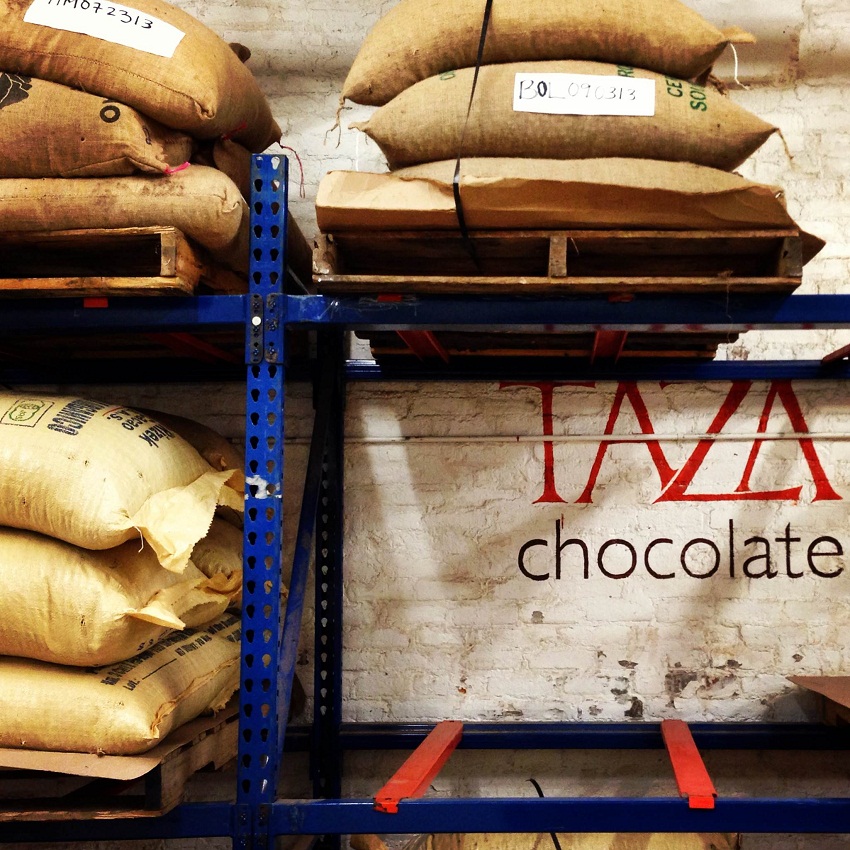Supply Chain: Going Bean to Bar at Somerville’s Taza Chocolate
Welcome to Supply Chain, where we go behind the plate to get a feel for the day-to-day of Boston’s most relied-upon restaurant purveyors.

Photo by Cassandra Landry
As he fills me in on his company, Taza Chocolate founder Alex Whitmore’s face seems to be constantly arranged in a cheery countenance—although, I suppose if my job consisted of trekking through South America to find the best cacao and the best people to get it from, bringing it back, and turning it into a feel-good chocolate phenomenon, mine would be too.
After bursting onto the scene in 2006 and getting hit with an unbelievable demand right out of the gate, Somerville-based Taza is as well-known in the professional cooking world as in the amateur chocolate lover’s. The rustic, gritty chocolate’s presence in dishes and products around the city runs the whole gamut, from cacao nibs in a Nightshift Brewery’s Taza Stout to occasional bowls of mole and riffs on traditional chocolate desserts on menus all over the place.
“Most people would be surprised to know that we’re in all 50 states, as well as Australia, Hong Kong, Norway, and the UK,” says marketing manager Robin Ruttle after she meets me in the lobby. “The cool thing about Taza is that we still feel really local all of these years later. You can’t take local-ness like that for granted, or you’ll lose it.”
Since you obviously aren’t going to find cacao growing in the wilds of New England, Taza’s Direct Trade program is the next best thing in a culinary landscape where local is king. Whitmore makes it a point to personally visit the farmers every year, and in doing so, maintains the soul of what people love about local food in the first place: the connections.
“Something like chocolate won’t fit into that local movement in a traditional sense. If you’re buying chocolate, there are so many levels to consider, from where it’s grown to where it’s processed,” Ruttle explains. “A company like Taza is so transparent about where they get their beans, where they get all their ingredients, how they make the chocolate … it’s more about being mindful about your food.”
If you’re wondering, this is what being mindful about your food looks like at the very deepest level: after the cacao beans have been sourced, Taza’s process begins by roasting them, which loosens the outer shells before they then pop into a machine called a winnower, which separates the shells from the nibs. The nibs then pass through molinos, Mexican stone mills, where they are ground into a thick paste called cocoa liquor. Raw cane sugar is added to the liquor in a mixing tank, where it develops into a mixture called chocolate mass. The mass is transferred to a second set of molinos for a final grind, then passed along to either a roll refiner (for a smoother texture found in the bars) or not (think the gritty texture found in the discs). From there, the chocolate is tempered and deposited into molds, cooled, and packaged.

Photo by Cassandra Landry
The appeal for chefs comes down to this balance of forthright transparency and explosive flavor and mouthfeel, a one-two punch that has made it easy to get and keep people on the Taza bandwagon.
“It’s been a pretty wild ride,” Whitmore says. “We’ve had to learn how to work with different types of customers very quickly, and chefs in particular have very unique needs.”
Those needs might include filling out a traditional dessert selection (the average restaurant list might include one chocolate dessert, one fruit, one cream, one cold), or simply staying ahead of the curve. On every menu, chefs must simultaneously satisfy the basic expectations of the diner and blow their minds with something new.
“You want to be doing something different, and I think that’s where finding really amazing local ingredients has played a big role over the last several years. Chefs are constantly vying for that really unique flavor or texture,” he continues. “That’s what chefs, especially those in the fine dining realm, are looking to do. Push the boundaries for what people expect, while still providing that baseline standard.”
Eastern Standard and Island Creek Oyster Bar pastry chef Lauren Kroesser is one of Taza’s biggest proponents, but she wasn’t completely sold at first. She admits that the gritty texture threw her off in the beginning, but she kept at it, tasting and experimenting until the natural acidity and brightness of Taza’s chocolate won her over. The grittiness—usually the first characteristic die-hard fans of the stuff bring up—followed suit soon after. These days, she tells me, she keeps a personal stash of the salt and pepper or salted almond discs in her desk drawer at all times.
“I no longer see the grittiness as bad,” Kroesser says, noting that Taza chocolate can actually be easily substituted into any recipe you could think of. “The only challenge may be convincing others that perfectly smooth is not necessarily an indicator of a good product.
“But once they’re hooked,” she adds, “they’ll be hooked for life.”
Last spring, Kroesser took her pastry teams at Eastern Standard and Island Creek Oyster Bar for a customary tour of the Somerville factory and proceeded to fall even further in love with the whole operation.
“Their vision and philosophies are really something to be envied,” she says. “It’s nice to support a company that has the passion that they do, as well as a superb product.”
Back at the office, Whitmore maintains a pride in their product that manages to avoid going down the tantalizing road of global domination. At the end of the day, he’s a dude who was deeply inspired by something he tasted in Oaxaca, and is now successfully offering up his interpretation to a ravenous public.
“We’re not going to usurp Valrhona or anything,” Whitmore says. “We just make a unique, niche ingredient that these chefs find amazing things to do with.”


